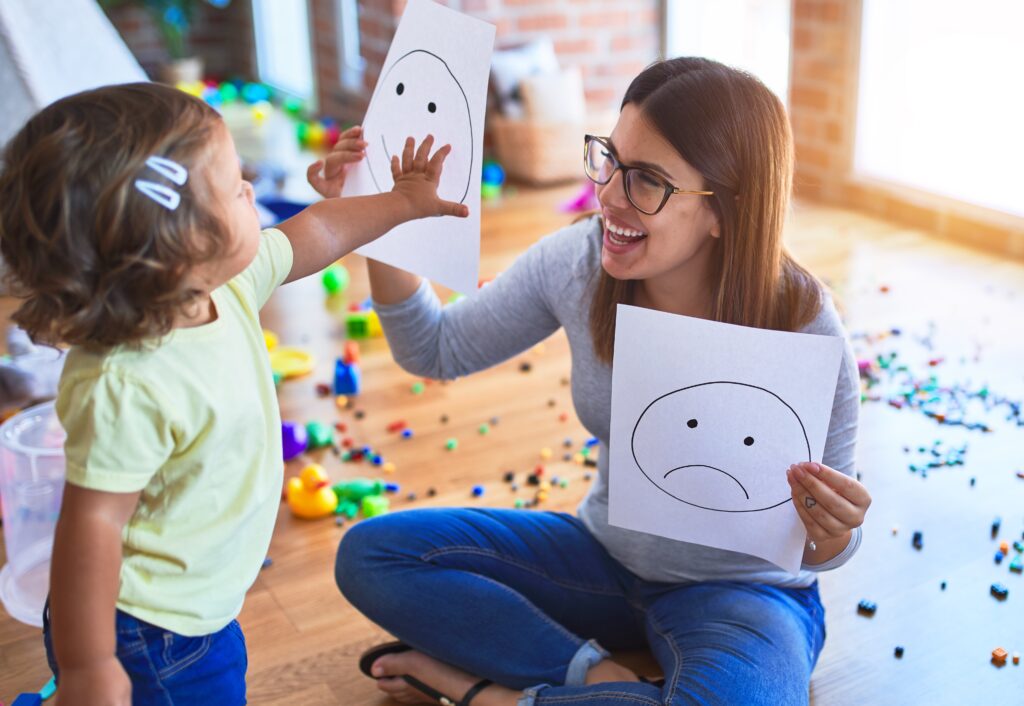Children, like adults, experience a wide range of emotions. As they develop (at any stage), they will benefit from active support from caregivers in helping them label, understand, express, and cope with various feelings. Studies show, that simply being able to label a negative feeling when experiencing it, helps to relieve some of the emotional distress that accompanies it (for children and adults). When children learn how to manage their feelings, they will feel empowered, socially successful, and have better personal insight. Not to mention, this will all make your job less difficult as a parent! Try these strategies for helping your child explore the world of various emotions and thereby increasing their emotional intelligence (which research has positively correlated with later success in life in both academic and professional pursuits).
- Stay “tuned in” to your child by watching them and listening to them when they express emotions verbally. Provide a non-judgmental stance by listening without interrupting. This creates a safe space for them to explore and make sense of their feelings themselves.
- Label the feeling your child is experiencing for them in the heat of the moment while still standing firm. For example, if your child is having a temper tantrum because you set a limit you may say: “You are angry and sad that I have removed electronics for the weekend.”
- Suggest an appropriate coping skill for them to use if they are headed down a road of harmful coping. In keeping with the scenario above you might add: “You are angry and sad that I have removed electronics for the weekend. Perhaps you will want to color your feelings on this paper or scream into your pillow to get your anger out.”
- Model appropriate emotional expression. This one is very critical as emotional regulation is a learned behavior. Every time you experience an emotion (positive or negative) in front of your child, it is an opportunity for them to learn how to label the emotion and manage it themselves. For example, label your own feelings out loud in a calm manner, using “I-Statements”. In keeping the scenario above you might add: “You are mad and frustrated that I have removed electronics for the weekend. I am disappointed that you pushed your sister because it is not safe and it is not nice.”
- Be aware of the difference between your child’s feelings and their behavior. Let your child know that it is okay and normal to experience all kinds of emotions, but if their behavior is hurting themselves or someone else, that is not okay. Take the time to discuss the difference with your child when they are emotionally regulated.
- Provide your child with un-structured but supervised play time where they can test some of what they learned in a natural environment. Only intervene if necessary. Often, children create their own natural consequences socially that can be great learning experiences on the topic of understanding and managing their emotions.
- Provide selective praise when you notice they did a great job managing an emotion. For example, “Samantha, you did a wonderful job expressing your anger with your brother this morning. I saw that you were mad and frustrated that he stole your stuffed bunny again and you made the right choice by telling him that this upset you and asking for it back rather than pushing him like last time. I can see that you are trying hard to make good choices and I am very proud of you!”
- Avoid physical punishment as this models the belief and conflict management style that the best way to deal with feelings or problems is with physical retaliation. For example, if your child breaks a rule and you spank them, they have just learned that hitting is an acceptable form of problem solving. For alternative methods of discipline and positive reinforcement strategies please contact Sarah Paulson, LPCC at Good Therapy San Diego.
- Make coping options visible! Developing a creative way to display coping skills for various emotions is worthwhile, as children will passively absorb these skills each time they are near the display without even realizing it. This also helps normalize various feeling and supports self-efficacy in children’s ability to choose how to express their feelings in a healthy way. Some of my favorite ways to do this with children is to cut out varying color scoops of ice cream using construction paper, gluing the scoops on a Sunday bowl or cone picture on a large paper, and writing a coping skill on each scoop while decorating. Another idea for an older child is to make a college of coping skills from old magazine pictures.
- Lastly, take care of yourself! Parenting is very challenging and you deserve some personal time! Find healthy ways to express your emotions and cope with emotional distress. Some ideas are taking a walk, doing an at-home spa day, listening to calming music, practicing yoga, meditation or mindfulness, or simply learning something new. The options are endless and only you will know what works for you by carving out the time to explore your self-care outlets. Good Luck!








